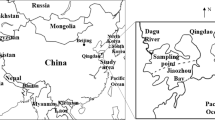Abstract
Based on the laboratory experiments with the saltwater and freshwater replacing each other in the level sand column, taking the kaolin, illite, smectite, bivalent hydrargyrum ion (Hg2+) and phenol (C6H5OH) as examples, this paper studies the applications of water sensitivity in situ remediation in saltwater-freshwater transition zone. In the water sensitivity process, the release and migration of clay minerals can make the hydraulic conductivity (HC) decrease and pollutants remove. A new type of low penetrable or impenetrable purdah can be built by adding clay minerals into the sand media to replace the underground concrete impenetrable wall to prevent seawater intrusion, and a number of the heavy metals and organic pollutants in the sand media can be removed by in situ remediation. The results show that the content of kaolin and illite influences the water sensitivity process slightly, and HC of the sand columns descends from 0.011 cm/s to 0.001 4 cm/s and 0.001 2 cm/s respectively even if the content reaches 12% (weight ratio, sic passim). However, for smectite, HC descends sharply to about 1×10−8 cm/s when its content reaches 4%, and no water can flow through the sand columns beyond 5%. The particle release and migration processes can remove the Hg2+ and C6H5OH out of the sand columns efficiently, the removing rate of Hg2+ is 31.68% when the freshwater and saltwater are filtered through the sand columns polluted by Hg2+, while it is 67.55% when the water sensitivity occurs. With the same method, the removing rates of C6H5OH under the fluid flow and water sensitivity are 55.71% and 43.43% respectively.
Similar content being viewed by others
References
Goldenberg L C, Mageritz. Experimental investigation on irreversible changes of hydraulic conductivity on the seawater-freshwater interface in coastal aquifer[J]. Water Resources Research, 1983, 19(1): 77–85.
Khilar K C, Fogler H S. Migrations of Fines in Porous Media[M]. Kluwer Academic Publishers, The Netherlands, 1998. 1–8.
Ryan J N, Elimelech M. Review: Colloid mobilization and transport in freshwater[J]. Colloids Surf A, 1996, 107: 1–56.
Mohan K K, Vaidya R N, Reed M G et al. Water sensitivity of sandstones containing swelling and non-swelling clays[J]. Colloids Surf A, 1993, 73: 237–254.
Gruesbeck C, Collins R E. Entrainment and deposition of fine particles in porous media[J]. Soc Pet Engin, 1982, 20(3): 847–856.
Kia S F, Folger H S. Effect of salt composition on clay release in Berea sandstone[J]. SPE Production Engineering, 1987, 26(4): 277–283.
Khilar K C, Vaudya R N, Fogler H S. Colloidally-induced fines release in porous media[J]. Petro Eng Sci, 1990, 22(4): 213–221.
Frenkel H, Goertzen J O, Rjoades J D. Effects of soil type and content, exchangeable sodium percentage, and electrolyte concentration on clay dispersion and soil hydraulic conductivity[J]. Soil Science Society of America Journal, 1978, 42(1): 32–39.
Zheng Xilai, Qian Hui. Dispersion degree mensuration of the porous media[J]. Journal of Xi’an Engineering College, 1998, 26(4): 51–56(in Chinese).
Xiao Zhenhua, Wan Hongfu. Influences to soil’s hydraulic and physical characters by the irrigating water quality [J]. Acta Pedalogica Sinica, 1998, 35(3): 359–366(in Chinese).
Goldberg L C, Mageritz. Changes in hydraulic conductivity of lab sand-clay mixtures caused by a seawater-freshwater interface[J]. Journal of Hydrology, 1984, 70(3): 283–297.
Theresa Blume, Noam Weisbrod, Selker. Permeability changes in layered sediments: Impact of particle release [J]. Freshwater, 2002, 40(5): 466–474.
Jalel Ochi, Jean-Francois, Vernoux. Permeability decrease in sandstone reservoirs by fluid injection hydrodynamic and chemical effects[J]. Journal of Hydrology, 1998, 208(5): 237–248.
Ashraf Shafaei, Farzin Zokaee Ashtiani, Tahereh Kaghazchi. Equilibrium studies of the sorption of Hg(II) ions onto chitosan[J]. Chemical Engineering Journal, 2007, 133(1–3): 311–316.
Grolimund D. Transport of in situ mobilized colloidal particles in packed soil columns[J]. Environmental Science and Technology, 1998, 32(22): 3562–3569.
Bunn A R. Mobilization of natural colloids from an iron oxide coated sand aquifer: Effect of pH and ionic strength [J]. Environment Science and Technology, 2002, 36(12): 314–322.
Author information
Authors and Affiliations
Corresponding author
Additional information
Supported by National Natural Science Foundation of China (No. 40572142).
HAN Zhiyong, born in 1976, male, Dr, associate Prof.
Rights and permissions
About this article
Cite this article
Han, Z., Zheng, X. & Chen, J. Applications of water sensitivity in situ remediation at saltwater-freshwater interface. Trans. Tianjin Univ. 15, 150–155 (2009). https://doi.org/10.1007/s12209-009-0027-0
Accepted:
Published:
Issue Date:
DOI: https://doi.org/10.1007/s12209-009-0027-0




